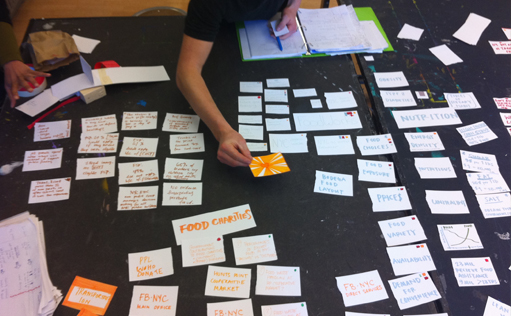Food Systems Research Synopsis
Posted on April 11, 2011 | posted by:Research Team: Jacqueline Cooksey, Eulani Labay, Steven Dale, Aabhira Aditya, Mai Kobori, and Bland Hoke
Food Systems are complex, interconnected and widespread networks of individuals, organizations, and consumables. In researching the urban food ecosystem in Hunts Point, the Food Systems group sought to understand three segments of the system including: the influences public and private organizations have on food distribution; large aid organizations’ influence on the distribution of food to low income populations, and the infrastructures of food. The team used methods that included literary research, fieldwork, interviews, and observations.
– Government assistance programs: Food access programs include SNAP (Supplemental Nutrition Assistance Program, formerly known as Food Stamps), designed to provide low-income households with electronic benefits they can use at most grocery stores; and WIC (Women, infants, children), which provides Federal grants to States for supplemental foods, health care referrals, and nutrition education for low-income pregnant, breastfeeding, and non-breastfeeding postpartum women, and to infants and children up to age five who are found to be at nutritional risk.
– Charity organizations: The Food Bank of New York City, known as the primary food charity for the entire city, has its warehouse in Hunts Point. The Food Bank offers services that improve prospects for food access (such as nutrition education or community supported agriculture); but its programs in Hunts Point are limited to emergency food programs (such as food pantries and soup kitchens). Grassroots and community organizations, such as the Hunts Point Children’s Alliance and The Point Community Development Corporation, tend to lead the way in promoting healthy diets and lifestyles to local residents.
– Infrastructure of Food: This topic expounded on the tangible nature of food through the lens of the food cycle. During our initial examination of the food production, distribution, and consumption, we asked, “What is gained and lost at each phase of the food cycle?” This inquiry was pursued as a means to parse the related information.
o Nutrition (lost) – To simplify the loss of nutrition, a carrot was used to represent nutrition depending on how the vegetable is processed for sale (frozen or canned) and how it is prepared (cooked, dried, cook and drained, etc). Furthermore, to understand the local realities of healthy food access in the Hunts Point area, our team set out to do fieldwork research by employing ethnographic research methods. Observations and interviews with grocery store shoppers, bodega owners, and a nutritionist allowed us to gather compelling insights on the infrastructure of food in the Hunts Point community.
o Waste (gained) – Throughout the food cycle, waste is generated at every stage of production, distribution, consumption, and post-consumption. Unlike the packaging, pallets, and containers that facilitate the dispensation of food, the organic waste in New York City is largely neglected as a marketable resource. Small scale initiatives such as the Community Compost Program at Union Square capture .04% of residential organic waste, while on a larger scale, technologies such as an anaerobic digester may provide energy and usable compost material from waste produced by the Hunts Point Terminal Market.
INSIGHTS
Research results were corroborated using an interactive game system designed to help connect the accumulation of information collected by the 3 subgroups over the course of 8 weeks. The team developed and iterated a system of establishing connections, links, and rule sets to create a new way to interacting as a team. The game, ‘Spark’ helped bring new meanings and connections while establishing transversal relationships across data and facilitating the cross-pollination of speculations.
Spark generated a series of collaboratively constructed assemblages, which were distilled to a working hypothesis that incorporates the group’s diverse findings. In order of scale, from macro to micro level, the hypothesis is:
– Food quality in Hunts Point is largely influenced by the contributions received by emergency food programs;
– Barriers (language, paperwork, etc.) prevent the use of food-access programs and services;
– Dependency on food-access programs and services creates stigma, which in turn prevents the active adoption and use of the programs.
